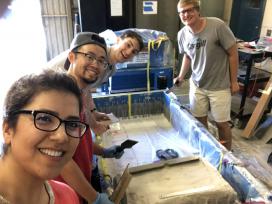ERC Soil Treatment Tests Show Promise for Reducing Settlement during Earthquakes
The Center for Bio-mediated and Bio-inspired Geotechnics (CBBG), an NSF-funded Engineering Research Center (ERC) headquartered at Arizona State University (ASU), is testing the treatment of soil with microbially induced carbonate precipitation (MICP) to induce properties that would mitigate the impact of earthquakes, which can cause soil to lose firmness and shift.
Earthquakes generate ground motions that may cause loose and granular soils to act like a liquid, damaging nearby infrastructure. The Center’s tests of MICP-treated soil show promise for reducing the incidence of soil shifting during earthquake-like movements, which would reduce both human and monetary costs of damage from quakes.
Using large and small centrifuges, CBBG researchers are testing the ability of MICP-treated soils to mitigate liquefaction and lowering of the ground surface – known as settling – that often occurs during an earthquake. Large centrifuge tests showed that MICP-treated areas experienced reduced pressure and prevented liquification. Tests also showed a reduction in settlement in treated soils, including up to 90 percent reduction in areas with buildings.
This technology can improve earthquake safety and remediation in the approximately 40 percent of the United States that the National Seismic Hazard Map has identified as having a 90 percent chance of experiencing soil liquefaction-triggering earthquakes in the next 250 years.



